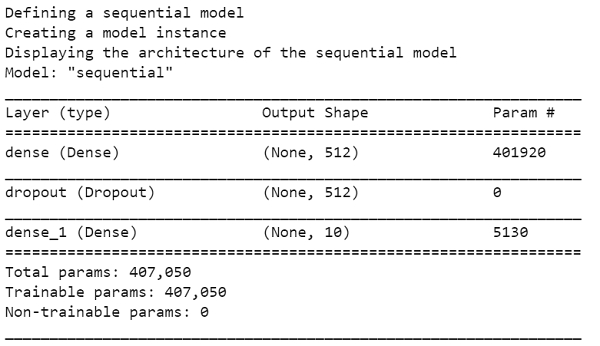
 Data Structure
Data Structure Networking
Networking RDBMS
RDBMS Operating System
Operating System Java
Java MS Excel
MS Excel iOS
iOS HTML
HTML CSS
CSS Android
Android Python
Python C Programming
C Programming C++
C++ C#
C# MongoDB
MongoDB MySQL
MySQL Javascript
Javascript PHP
PHP
- Selected Reading
- UPSC IAS Exams Notes
- Developer's Best Practices
- Questions and Answers
- Effective Resume Writing
- HR Interview Questions
- Computer Glossary
- Who is Who
How can Tensorflow be used to define a model for MNIST dataset?
Tensorflow is a machine learning framework that is provided by Google. It is an open−source framework used in conjunction with Python to implement algorithms, deep learning applications and much more. It has optimization techniques that help in performing complicated mathematical operations quickly. This is because it uses NumPy and multi−dimensional arrays. These multi−dimensional arrays are also known as ‘tensors’. The framework supports working with deep neural network.
The ‘tensorflow’ package can be installed on Windows using the below line of code −
pip install tensorflow
Tensor is a data structure used in TensorFlow. It helps connect edges in a flow diagram. This flow diagram is known as the ‘Data flow graph’. Tensors are nothing but multidimensional array or a list.
Keras is a deep learning API, which is written in Python. It is a high-level API that has a productive interface that helps solve machine learning problems. It runs on top of Tensorflow framework. It was built to help experiment in a quick manner. Keras is already present within the Tensorflow package. It can be accessed using the below line of code.
import tensorflow from tensorflow import keras
We are using the Google Colaboratory to run the below code. Google Colab or Colaboratory helps run Python code over the browser and requires zero configuration and free access to GPUs (Graphical Processing Units). Colaboratory has been built on top of Jupyter Notebook. Following is the code snippet −
Example
print("Defining a sequential model")
def create_model():
model = tf.keras.models.Sequential([
keras.layers.Dense(512, activation='relu', input_shape=(784,)),
keras.layers.Dropout(0.2),
keras.layers.Dense(10)
])
model.compile(optimizer='adam',
loss=tf.losses.SparseCategoricalCrossentropy(from_logits=True),
metrics=[tf.metrics.SparseCategoricalAccuracy()])
return model
print("Creating a model instance")
model = create_model()
print("Displaying the architecture of the sequential model")
model.summary()
Code credit − https://www.tensorflow.org/tutorials/keras/save_and_load
Output

Explanation
A sequential model is created using Keras.
The layers are created which are ‘dense’.
This model is compiled.
An instance of this model is created.
Details about this model are displayed on the screen using the ‘summary’ method.

